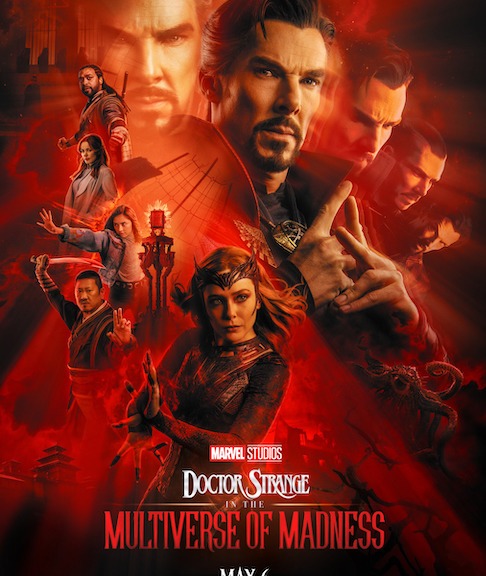Benedict Cumberbatch and Elizabeth Olsen do their best in Sam Raimi’s woebegone sequel.
Frequently incomprehensible, occasionally ludicrous, but never predictable, Doctor Strange in the Multiverse of Madness marks a dispiriting return to feature filmmaking for director Sam Raimi, though it’s business as usual for producer Kevin Feige.
Raimi enlivened the 1980s by helming a trio of energetic, low-budget genre pictures before his peak period in the 90s with the wildly entertaining Darkman, Army of Darkness and The Quick and the Dead, followed by the masterfully controlled A Simple Plan. His baseball picture, For the Love of the Game, was surprisingly listless, but he quickly rebounded with The Gift, which was a good springboard to his widest mainstream success with the first two of his Spider-Man films.
His third Spider-Man flailed under the weight of raised expectations and an overstuffed plot, though the relatively low-budget Drag Me to Hell appeared to revive his spirits before Oz the Great and Powerful signaled a shift to more anonymous filmmaking. In the years since then, Raimi has kept busy as a producer.
His signature careening camera moves are entirely absent from his latest endeavor, which resembles the newest model rolling off the Kevin Feige factory line. Scott Derrickson, who co-wrote (with C. Robert Cargill) and directed Doctor Strange in 2016, walked away from the sequel, and it now appears to have been a harbinger of creative disaster. Michael Waldron is the sole credited writer on Doctor Strange in the Multiverse of Madness, which is surprising since it feels like a movie cobbled together by a writing room, all typing on wet napkins.
Waldron created Loki for Disney Plus, which premiered in 2021 and endeavored to explain Marvel’s multiverse concept in a series of increasingly confusing episodes. What the series demonstrated was that the concept gives Marvel much greater territory to play in while simultaneously dulling any potential consequences for every character, thus reducing any possible rooting interest for viewers.
Spider-Man: Far From Home showed that it is possible to play with the concept when the characters are given priority. Doctor Strange in the Multiverse of Madness provides a vivid template of what not to do: give priority to an overwhelming and confusing series of images and worlds and settings, and giving only lip service to the characters who might it all worth enduring.
Hidden in the blitzkrieg of pixels, Doctor Strange (Benedict Cumberbatch) faces off against Wanda Maximoff, aka Scarlet Witch (Elizabeth Olsen), who becomes the personification of evil, willing to torch the universe because she wants to be reunited with her two young sons. She relentlessly pursues teenager America Chavez (Xochitl Gomez), who can somehow travel across multiple universes, in order to rob her of her powers, prompting America to seek out Doctor Strange, who calls upon his warlock superior Wong (Benedict Wong) for assistance, even as he continues to pine for his lost love, Doctor Christine Palmer (Rachel McAdams).
From there (and even before the plot is explicated), the movie jogs through one visual effects sequence after another with diminishing effect, as though a large crowd were running through one planetarium after another. It’s potentially dazzling, though the reality of watching the movie becomes wearisome.
The film opens in Dallas, Fort Worth and surrounding cities on Friday, May 6, via Disney. For more information about the film, visit the official site.
